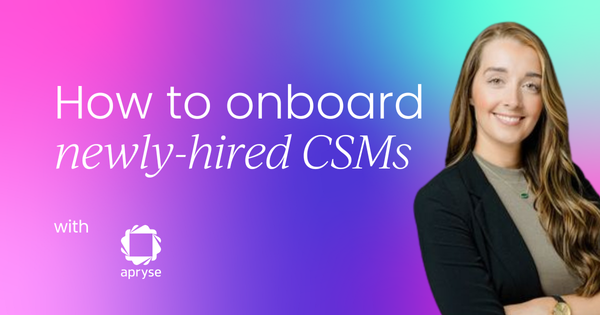This article is based on Jess Galeski's appearance on the CS School podcast.
As a customer success leader, I can't emphasize enough the importance of having a solid onboarding process for new Customer Success Managers (CSMs). Just like we strive to deliver an amazing onboarding experience for our customers, setting up our employees for success from day one should be a top priority.
I've been in the customer success field for over 13 years now, starting when it was just becoming a "buzzword." I've worn multiple hats – from being an individual contributor to leading teams as a manager. But one thing that has always been crucial, no matter which role I'm in, is ensuring my team members have a structured and thoughtful onboarding experience.
At Apryse, where I currently serve as the Director of Customer Success overseeing a team of eight CSMs, I'm super passionate about onboarding precisely because of how it sets the tone and lays the foundation for our new hires' journeys within the company.
In this article, we’re going to explore:
- The significance of onboarding your new hires properly
- Setting clear goals and milestones in the first 90 days
- Equipping new CSMs with relevant training and resources
- Facilitating cross-functional relationships from the start
- Encouraging curiosity, feedback and confidence
The vital importance of onboarding new hire Customer Success Managers
Having been on the other side, where I've joined companies with minimal or no formal onboarding, I know how intimidating and overwhelming it can feel to be "thrown things" without much guidance or support. I've experienced this at large companies, small startups, and everywhere in between.
The consequences of poor or nonexistent onboarding can be severe - from lower productivity and employee engagement to higher turnover rates. And let's not forget the potential negative impact on the customer experience if our CSMs don't have the proper training and resources.
That's why I take onboarding so seriously. It's not just about checking boxes or completing paperwork. It's about creating a sustainable environment where our new hires can thrive, feel valued, and ultimately, drive successful customer outcomes.
Setting clear goals and milestones for the first 90 days
One of the core elements of our onboarding process is providing new CSMs with a comprehensive 90-day plan that outlines clear goals, expectations, and milestones. Before they even start, I send out a welcome email with a detailed onboarding packet that breaks down what they can expect during their first week, first 30 days, and the subsequent 60 days.
The first week is typically dedicated to getting their tech set up, and ensuring they have access to all our systems and tools. The first 30 days are focused on understanding our processes, reviewing product offerings through online videos and resources, and getting a high-level overview of their day-to-day responsibilities.
In the following 60 days, we dive deeper into the product itself. This is when they'll meet our product team and engineers, and start to feel more acclimated with the technical aspects of what we offer and how our customers use it.
I've found that this structured approach, which gradually builds up from understanding their role and processes to mastering the product, is more digestible and less overwhelming for new hires.
Along with the 90-day plan, I also assign each new CSM an "onboarding buddy" from the existing team. I introduce them via the welcome email so they know they have a go-to person and an additional line of support during those crucial first few months.

Equipping new CSMs with relevant training and resources
Of course, no onboarding process would be complete without providing new hires with the resources and training they need to succeed. This includes access to comprehensive playbooks that outline our processes step-by-step, as well as product documentation, battle cards, and one-pagers covering common customer questions and use cases.
While reading through these materials is important, I also emphasize the value of hands-on training and knowledge sharing. Throughout the onboarding period, I set up live sessions where new CSMs can walk through our processes with experienced team members and their dedicated onboarding “buddy.”
I've found that this interactive approach, coupled with self-paced learning through documentation and videos, creates a more well-rounded and effective learning experience.
Additionally, I make it a point to introduce new hires to our wider network of internal resources and subject matter experts. This could be setting up meetings with members of our sales, marketing, finance, or engineering teams – essentially anyone they may need to collaborate with in their day-to-day roles.
The goal here is to ensure they don't feel like they're operating in the unknown, but rather, have a clear understanding of who they can turn to for specific queries or support.

Facilitating cross-functional connections from the start
Speaking of cross-functional collaboration, it's absolutely vital for new CSMs to build strong relationships with other teams from the get-go. Customer success sits at the center of any organization, acting as the hub that connects and facilitates communication between various departments.
That's why I prioritize setting up initial meetings and "warm introductions" between our new hires and key stakeholders across the company. Whether it's sales leaders, marketers, product managers, or engineers, these conversations serve two purposes:
- They provide new CSMs with a holistic understanding of how we work together as an organization and what each team's responsibilities are.
- They help establish those all-important connections and open lines of communication that will be instrumental for our CSMs to effectively manage the customer life cycle.
To streamline this process, I always give the relevant team members some context before their introductory call or meeting. I'll outline specific projects, processes or areas where they may need to collaborate with the new CSM. This way, everyone is on the same page and can have a more meaningful, productive conversation.

Encouraging curiosity, feedback and continuous improvement
One piece of advice I always give new CSM hires is this:
Be curious, ask lots of questions, and don't hesitate to provide feedback or suggestions. There's no such thing as a "silly" question, especially during those first few months when everything is new.
I make it a point to reiterate that their onboarding plan is a living, working document that can (and should) be updated based on their unique experiences and perspectives. After all, no two people learn or work in exactly the same way.
To facilitate this open dialogue, I have frequent check-in meetings with new hires during their first 90 days – sometimes daily, but at least every other day. These quick 15-minute syncs give them the opportunity to discuss what they've accomplished, raise any roadblocks they're facing, and let me know if they need additional support or resources.
If I notice someone is being unusually quiet or saying "everything's good" a little too often, that's a red flag for me. It likely means they're either holding back on asking for help due to shyness, or there are gaps in the onboarding that I need to address.
In those cases, I have an open and honest conversation to dig deeper into their experience so far. I may ask targeted questions like:
"I find it interesting that you're not asking a lot of questions. Normally at this stage, people have queries about X,Y and Z areas. So I'm wondering – are you truly getting value from this process? Is there anything missing that we should add or change?"
The key is to create a psychologically safe environment where new CSMs feel empowered to speak up, give candid feedback, and know that their perspectives are valued. It's the only way we can continuously improve and refine our onboarding to better set up each new hire for long-term success.

Conclusion
At the end of the day, taking the time to build out a robust, well-structured onboarding experience for new customer success managers is an investment that pays dividends for the entire organization.
Not only does it improve employee engagement, productivity and retention, but it also ensures that our CSMs have the skills, knowledge and cross-functional relationships they need to properly support our customers from day one. And in our world, delivering an exceptional customer experience is everything.
So if you're a customer success leader looking to elevate your onboarding game, I cannot emphasize enough the importance of:
- Providing new hires with a clear roadmap and milestones for their first 90 days
- Equipping them with on-demand training resources as well as hands-on learning opportunities
- Facilitating introductions and connections across teams from the get-go
- Fostering an environment of curiosity, feedback and continuous improvement
It's a multi-pronged approach that admittedly requires effort and commitment. But I can say from experience that it's one of the most worthwhile investments you can make into the long-term success of your customer success managers – and by extension, your customers.
So don't wait. Get started on revamping your CSM onboarding process today. Your employees, customers, and the health of your business will thank you for it.
Want to level up as a customer success leader?
If you enjoyed reading what one of the world’s brightest CS leaders had to say, you might want to enroll in our Customer Success Certified: Leadership program and become one of tomorrow's champions of customer success.
What to expect in this nail-biter of a course
👥 Master customer-business harmony
Balance customer needs with business growth through effective renewal and expansion strategies.
💡 Advance in data and communication
Gain data analytics skills and enhance communication for strategic decision-making and strong relationships.
📈 Lead and grow in your career



 Follow us on LinkedIn
Follow us on LinkedIn




